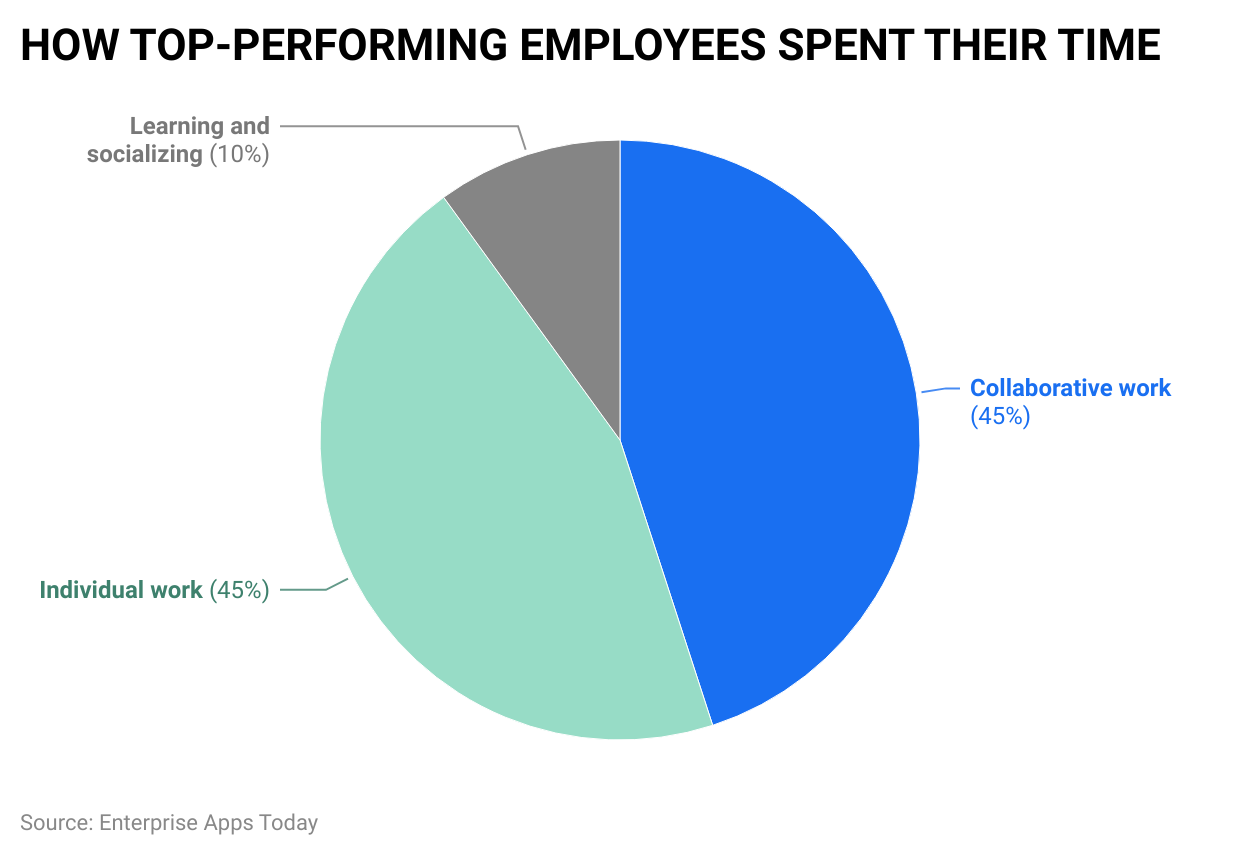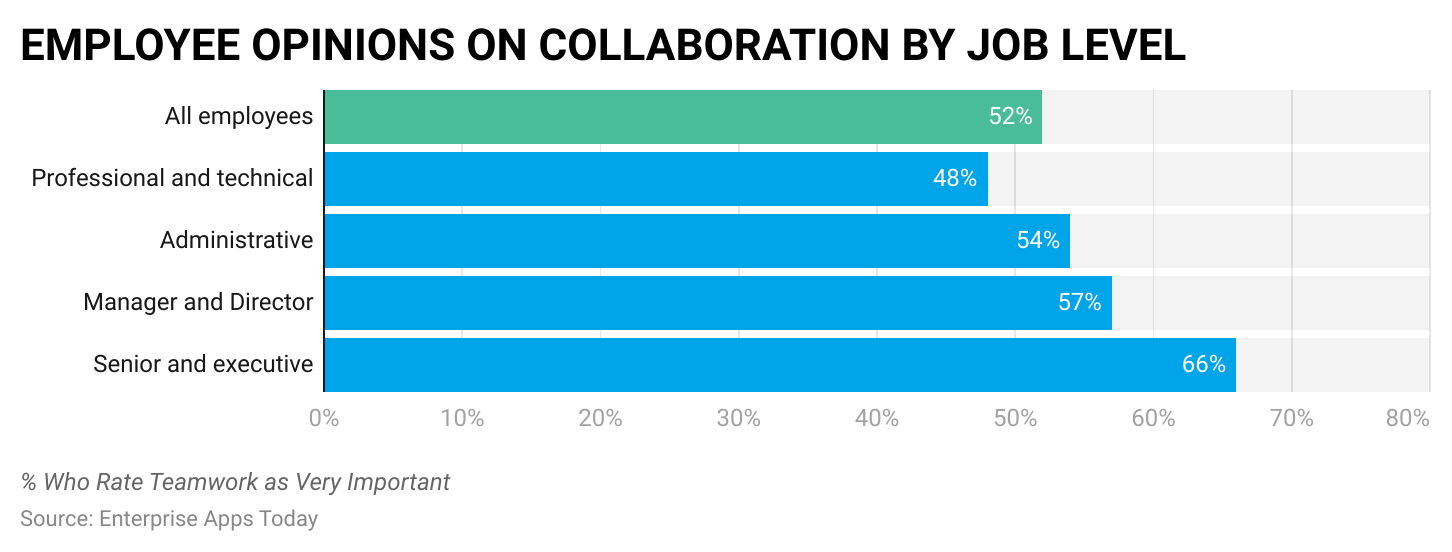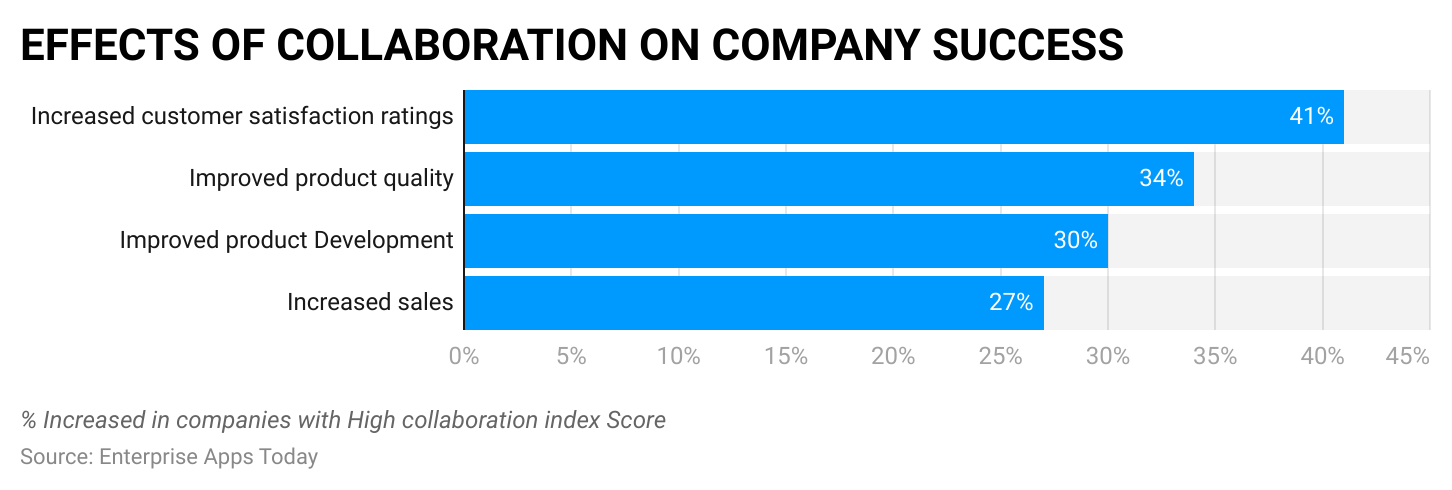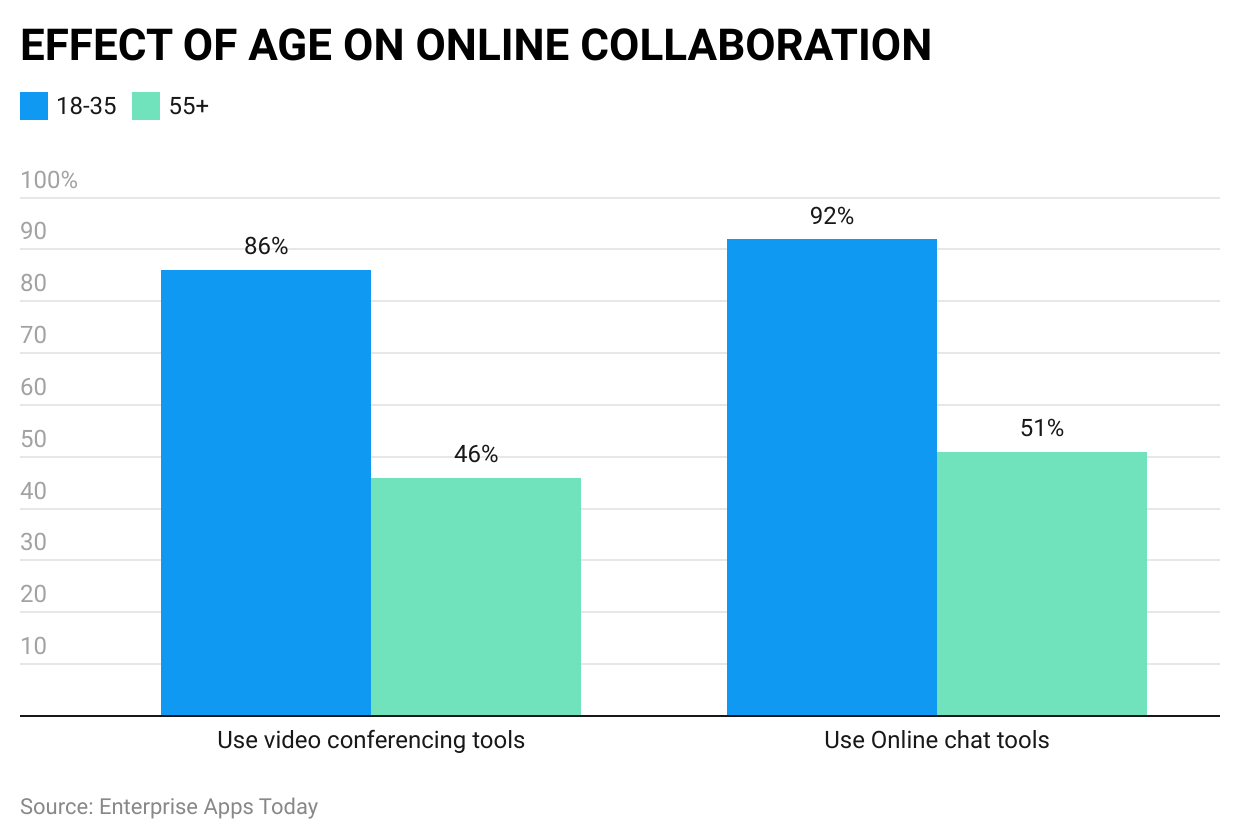25+ Eye-Opening Workplace Collaboration Statistics, Trends and Facts

Page Contents
- Key Workplace Collaboration Statistics (Editor's Choice)
- General Workplace Collaboration Statistics
- Online Collaboration Statistics
- Individual Work Vs. Teamwork Statistics
- Advantages Of Collaboration In the Workplace
- Benefits of Effective Teamwork Collaboration
- Workplace Collaboration Problems
- Workplace Collaboration Trends
- Conclusion
workplace collaboration statistics: The word “collaboration” is a magic buzzword that businesses worldwide love. When employees collaborate well, they are more productive and faster, which results in more output for the organization.
Everyone is aware that working in groups is more efficient. It is possible to share your creativity, resources, and strengths with others in order to achieve objectives and complete tasks.
Here are some vital workplace collaboration statistics that will help you understand how crucial it is in the workplace and how it can transform your workforce.
Let's get started.
Key Workplace Collaboration Statistics (Editor's Choice)
- Fully operational communication systems can increase a company's ability to retain top employees by up to 450%.
- Digital collaboration statistics show that digital workplaces and online collaboration software can increase productivity by as much as 30%.
- In the United States, more than 50% of workers have accepted that their jobs become more reliant after workplace collaboration in 2023.
- Online collaboration tools are used by 56% of employers for making effective communication with employees.
- The top reason for workplace failure in leadership positions is lack of collaboration stated by 86% of global employees.
- Employee turnover rates have been reduced by 50% by promoting collaboration and communication in the workplace.
- Engagement in collaboration at work made employees satisfied by 17% more satisfied in 2023.
- Workplace collaboration has increased by 50% in the last 20 years.
- The market revenue of project collaboration software is expected to be $13.333 billion and $13.582 billion by the end of 2023 and 2024 respectively.
- 70% of workers say that digital technology has increased their collaboration.
- Virtual team collaboration statistics show that remote working can save employers up to $11,000 annually.
- Nearly 52% of United States professionals rate teamwork as extremely important.
- Only 30% of workers think their colleagues are devoted to delivering high-quality work.
- 83% of workers say they use technology to collaborate.
- Workplace collaboration and teamwork initiatives boost business sales by 27%.
- By 2023, it is expected that spending on augmented reality (AR)and virtual reality (VR) in corporate training will reach $2.8 billion.
- Peer collaboration apps positively enhance the rate of employees by 81%.
- Around 53% of people in the United States are unhappy at their jobs.
- 9% of professionals describe successful team collaboration as being able to communicate effectively with their team members.
- One of the top four essential skills for employees' future success is collaboration.
General Workplace Collaboration Statistics
Although systems that encourage collaboration in the workplace were developed in the 1960s, why are they still applicable today? Many young adults select occupations that include teamwork because they desire the opportunity to grow, serve on a team, learn, and enjoy working with coworkers.
Numerous workplace collaboration stats from 2019 showed that many businesses with collaborative staff tend to stay together and thrive as a group.
Online Collaboration Statistics
Various online collaboration tools help you create a cohesive and efficient workforce. Businesses have been transformed by video and conference call services, teamwork platforms and applications, and collaborative document editing.
The following 5 stats demonstrate how business has benefited from online collaboration.
#1. Fully operational communication systems can increase a company's ability to retain top employees by up to 450%.
Around 61% of US workers voluntarily left their employment in 2023. Businesses can increase employee retention of their finest talent and skills by up to 4.5 times by implementing more efficient communication systems.
#2. Digital collaboration statistics show that digital workplaces and online collaboration software can increase productivity by as much as 50%.
Project management platforms are one example of a tool that helps workplaces with improved cooperation and output. If workplace productivity can be increased by 20-30% using online collaboration tools and digital workplaces, other companies will likely not benefit.
#3. Top-performing employees spend nearly 45% of their time working individually, around 5% of their time working collaboratively, and roughly 10% of their time socializing and learning.
According to data, top-performing employees in American companies are equally likely to engage in both collaborative and individual work.

(Source: Zippia)
#4. 70% of workers say that digital technology has increased their collaboration.
It is hard not to think of staff not using modern technology to their company's benefit. Effective use of digital technology in the workplace by 7 out of 10 workers will inevitably lead to increased productivity and teamwork.
#5. Virtual team collaboration statistics show that remote working can save employers up to $11,000 annually as of June 2023.
You read that right! Employees can be permitted to work from home simply by offering remote work benefits. Considering that several work-from-home stats indicate that around 3.7 million US employees work remotely at least half the time, this is a considerable amount of money.
Furthermore, Numerous telecommuting statistics support that people working remotely are more productive because they take fewer sick days, shorter breaks, and fewer vacation days.
#6. Nearly 50% of United States professionals rate teamwork as extremely important.
The majority of American workers consider teamwork to be essential to their professional success. According to a workplace poll by Gensler, nearly 48% of technical workers and professionals, 54% of administrative workers, 57% of directors & managers, and 66% of executive and senior workers feel that their jobs depend on in-person communication.

(Source: Zippia)
#7. 83% of workers say they use technology to collaborate.
It turns out that while over 3-quarters of team members trust technology to help them work together, more than 50% find it challenging to use the company's online resources. 3 out of 10 telecommunications-related businesses are entirely virtual and rely on online collaboration.
Individual Work Vs. Teamwork Statistics
Some employees love to collaborate, while others prefer to work independently. Let's look at some vital stats to understand how collaboration impacts the workplace.
#8. Fewer than 30% of Millennials are actively engaged at work.
Approximately one-third of Millennials are emotionally, actively, and behaviorally connected to their job. They put little effort and energy into their employment because 16% are actively disengaged, and more than 50% are not engaged at all.
#9. Only 30% of workers think their colleagues are devoted to delivering high-quality work.
Office collaboration works for some people but not others, which is interesting. 1 out of 3 employees says that their coworkers are contributing to the workload. This means that 70% of employees don't trust their colleagues to do their work.
#10. Millennials and Gen Zs already account for more than one-third of the workforce.
Approximately 50% of the younger generation holds director or higher level positions, along with 30% of Millennials in the existing workforce.
Furthermore, Millennials are expected to make up 75% of the global workforce by 2025. This will significantly impact the future corporate culture of large corporations and their collaboration & communication statistics.
#11. According to about 75% of workers, teamwork and collaboration are essential.
Less than 20% of employees receive communication reviews as part of their performance reviews, despite nearly three-quarters of them enjoying working as a team. In addition, 39% of poll participants said their firm could collaborate more.
Advantages Of Collaboration In the Workplace
You already know that performance is driven by enthusiasm. People who are passionate about their work are driven to improve. Let's look at some crucial stats at the workplace that help to understand the benefits of teamwork.
#12. Teams with high connectivity show a 21% boost in profitability.
It's good news! There is a 41% reduction in absenteeism among teams in the top 20% in terms of connectivity. These workplace wellness stats indicate that around 59% fewer employees quit their jobs. Employees who feel valued and supported are likelier to put up their best effort and help their firm succeed.
#13. Team building statistics show that nearly 70% of employees said they would spend additional time on collaborative platforms in the future as of March 2023.
It is heartening that almost three-quarters of workers believe that workplace collaboration will play a more significant role in the future. It is also expected that business-related instant messaging and social media will expand. There will be many options for communicating with coworkers via multiple platforms.
#14. Workplace collaboration and teamwork initiatives boost business sales by 27%.
According to statistics from Frost & Sullivan, a company's collaboration index boosts sales by 27% and increases customer satisfaction ratings by nearly 41%. The study also revealed that teamwork enhances product development by 30% and product quality by 34%.
 (Source: Zippia)
(Source: Zippia)
#15. Collaboration is one of the top four essential skills for employees' future success.
Communication was rated as the essential ability in the poll. Collaboration was among the top four crucial skills that would help employees succeed in the future, along with critical thinking and leadership.
#16. Most employees who face the highest rate of burnout are aged between 18 to 24 years of age
However, up to 47% of employees report experiencing significant stress. A corporation may share tasks, responsibilities, and other duties more evenly in order to increase productivity.
#17. Compared to unhappy employees, cheerful employees can improve their productivity by up to 20%.
In August 2023, there were 134.19 million full-time workers in the United States. Consider the advantages of having one-fifth of a full-time workforce that is happier and more productive. As a result, there has been an increase in national productivity by 3.7% in the 2nd quarter of 2023.
Benefits of Effective Teamwork Collaboration
- In 2023, employee engagement has increased due to effective teamwork collaboration resulting higher profitability rate of 21% and a lower absenteeism rate of 41%.
- By the end of 2024, companies with effective workplace collaboration will help in enhancing higher revenue and productivity by 30%.
- According to the reports Forrester, productivity level has increased by 10% by driving effective improvements in team collaboration.
Workplace Collaboration Problems
Workers often feel isolated and unhappy because they do not feel heard. Let's look at the following important workplace collaboration stats that address related issues.
#18. Workers whose bosses take their suggestions seriously are 4 times more likely to stay in the organization.
A staff member's voice must be heard. It makes a huge difference to have substantially more eager employees to stay on board.
#19. 80% of employees in the United States report feeling stressed out as a result of poor workplace communication.
- As of 2023, almost 58% of employees left jobs due negative workplace politics. On the other hand, 31% of employees who believe that interpersonal relationship at workplace is the root cause of stress.
#20. Around 70% of people in the United States are unhappy at their jobs.
- This indicates that more than half of US workers are unhappy with their jobs. If 70% of workers have planned to quit their jobs because they feel underappreciated by the end of 2023, then perhaps improper communication is at least partially to blame.
#21. 13.9% of professionals describe successful team collaboration as being able to communicate effectively with their team members.
The poll on effective team collaboration shows that this was the most important definition. Other vital values in teamwork include:
- Having an understanding of each other's responsibilities.
- Trusting your colleagues to do their tasks.
- Being able to work well with others on both a professional and personal level.
#22. 86% of professionals in the United States would like to quit their jobs because poor communication makes it difficult for them to perform their jobs effectively.
In a poll of 1001 employees, poor communication was the reason why more than half of the respondents had to resign. The number of employees who reported poor communication as a reason for not being able to perform their jobs satisfactorily has almost doubled from 33% in 2018.
Workplace Collaboration Trends
With a growing number of platforms and possibilities like Teams, Slack, YouTube, and Zoom, visual and video collaboration are essential for the future. The following vital collaboration statistics will show how collaboration trends impact the company.
#23. Connected workspaces can minimize the amount of office space by saving around 40% on a corporate real estate lease.
Connected workspaces minimize each worker's overall square foot space allocation by allowing more individuals to work in the same office area. This can reduce the cost of renting a commercial property by as much as 40%.
#24. There are 90 million video conference huddle rooms available worldwide.
Huddle rooms are a growing trend that accounts for 8% of all video conferencing room meetings. Unsurprisingly, huddle rooms will make up almost 8 of 10 video conferencing room meetings by 2023.
#25. When it comes to using online collaboration tools at work, younger generations are more inclined than older generations.
Workers over 55 are roughly 41% more likely to prefer to work independently than workers ages 25 to 34.
Research also revealed that 86% of 25-34-year-old employees use video conferencing tools at their workplace, compared to 46% for employees 55 years and older. Approximately 92% of workers between the age of 18 to 34 use online chat tools to collaborate at their jobs, compared to 51% of those 55 years old.

(Source: Zippia)
#26. By 2023, Virtual Reality (VR) and Augmented Reality (AR) in corporate training are expected to reach $2.8 billion.
This global rise in demand demonstrates how Augmented Reality and Virtual Reality have transformed the corporate training experience and will do so for the foreseeable future.
Nowadays, there are options for workers to take part in worker simulations of real-life scenarios and access information in a secure setting without risk or threat to them.
#27. The global data analytics outsourcing market is anticipated to reach $20.68 billion by the end of 2026.
The demand for remote workers and virtual assistants is increasing along with our market's rapid expansion.
Furthermore, Employers will save up to 78% on yearly operational costs because more workers choose to work from home. It benefits both parties.
#28. According to millennial collaboration stats, more than 60% of Millennials and Generation X would prefer visual communication.
We are aware of how much younger generations enjoy expressing themselves. Best of all, consider the expanded commercial advantages of communicating and collaborating if 6 out of 10 people do it in a manner that they are more comfortable with.
Conclusion
Collaboration and effective communication with clients, coworkers, and supervisors are essential for professional success. Most data consistently demonstrate that workplace collaboration boosts productivity, creates a better work environment, and leads to greater profitability.
While there are some downsides to collaboration in the workplace, such as lack of recognition for team achievements and stress, over half of the American labor force relies on collaboration at work and considers teamwork highly vital to professional success. In fact, the majority of workers attribute failures in the workplace to a lack of teamwork.
Sources
FAQ.
The majority of professions require collaboration. Workplace collaboration is rated as "extremely important" by 52% of American workers. A smaller percentage of entry-level professionals believe teamwork is more important than senior or executive positions.
However, nearly 48% of workers believe that teamwork is crucial for their work, even at the lowest levels of the company.
McKinsey's comprehensive workplace study found that collaboration boosts productivity by almost 25%. The study examined the effect of improved collaboration via internal social tools. So it is possible that the overall effect of collaboration boost productivity by even higher than 25%.
For the best results, teams should consist of 4 to 9 members. Smaller groups are more likely to experience delays and knowledge or skill shortages, while larger teams frequently lack cohesion, responsibility, and efficiency.

Michael Singer is a career coach, podcast host, and author to help you step into a career you're excited about. Currently, He is a coach and trainer helping entrepreneurs and executives achieve business and leadership success. He is also an award-winning business journalist focused on the intersection of technology, Big Data, Cloud, SaaS, SAP, and other trending technology.